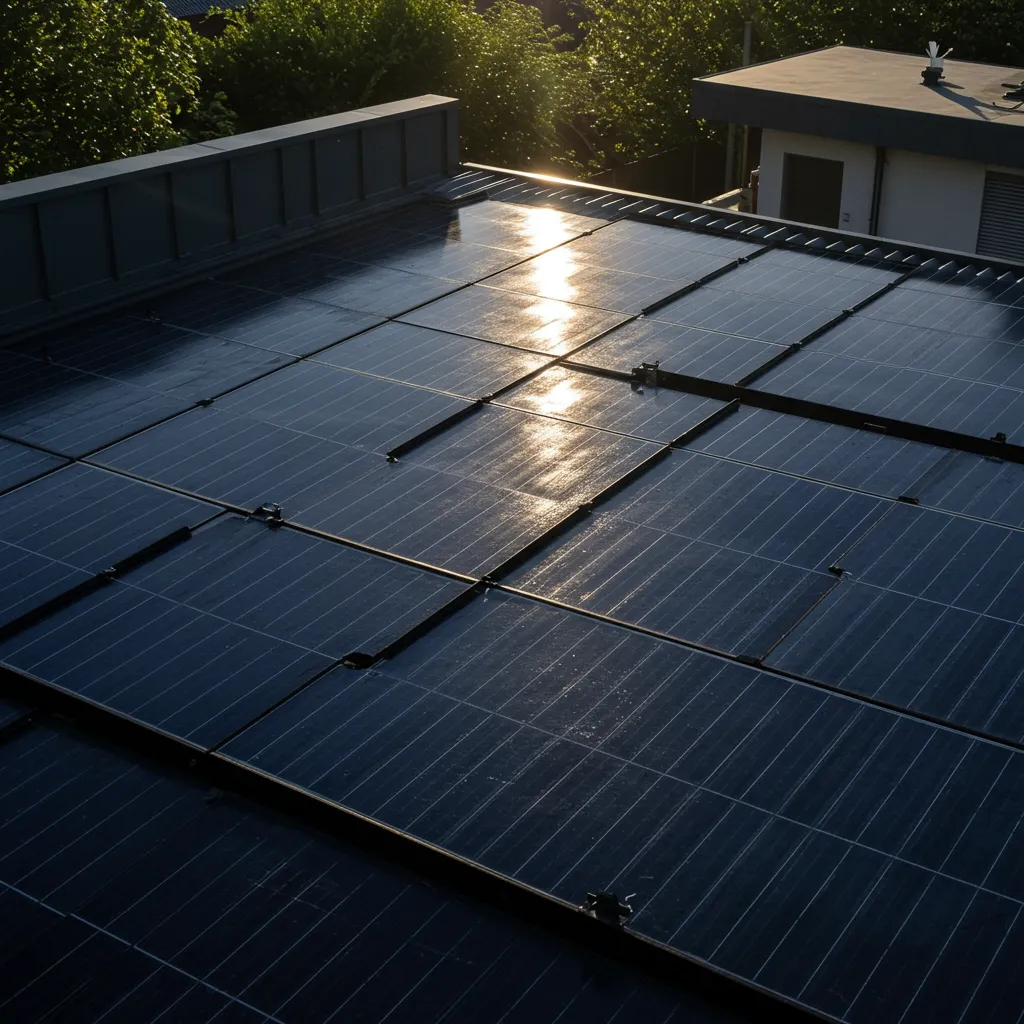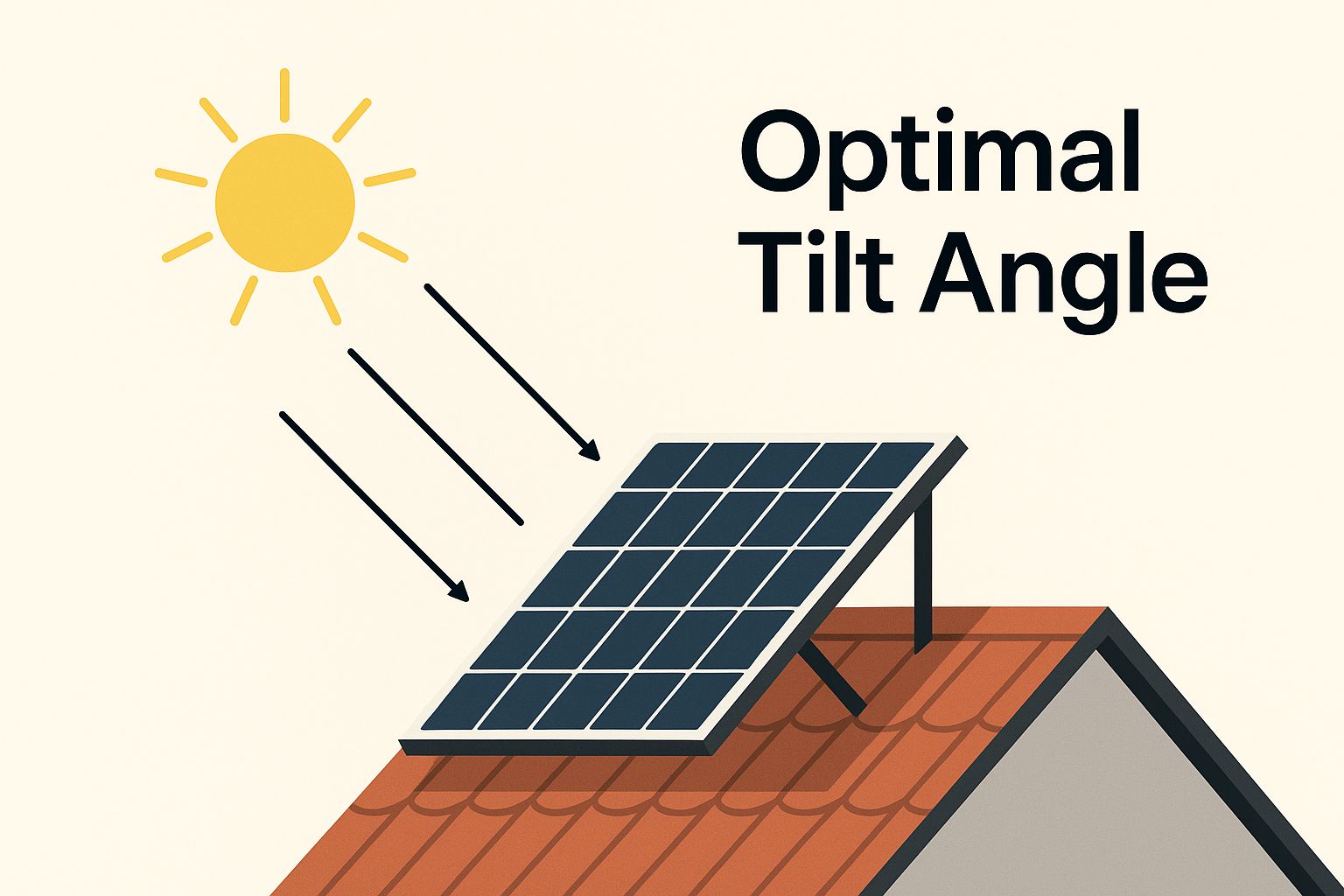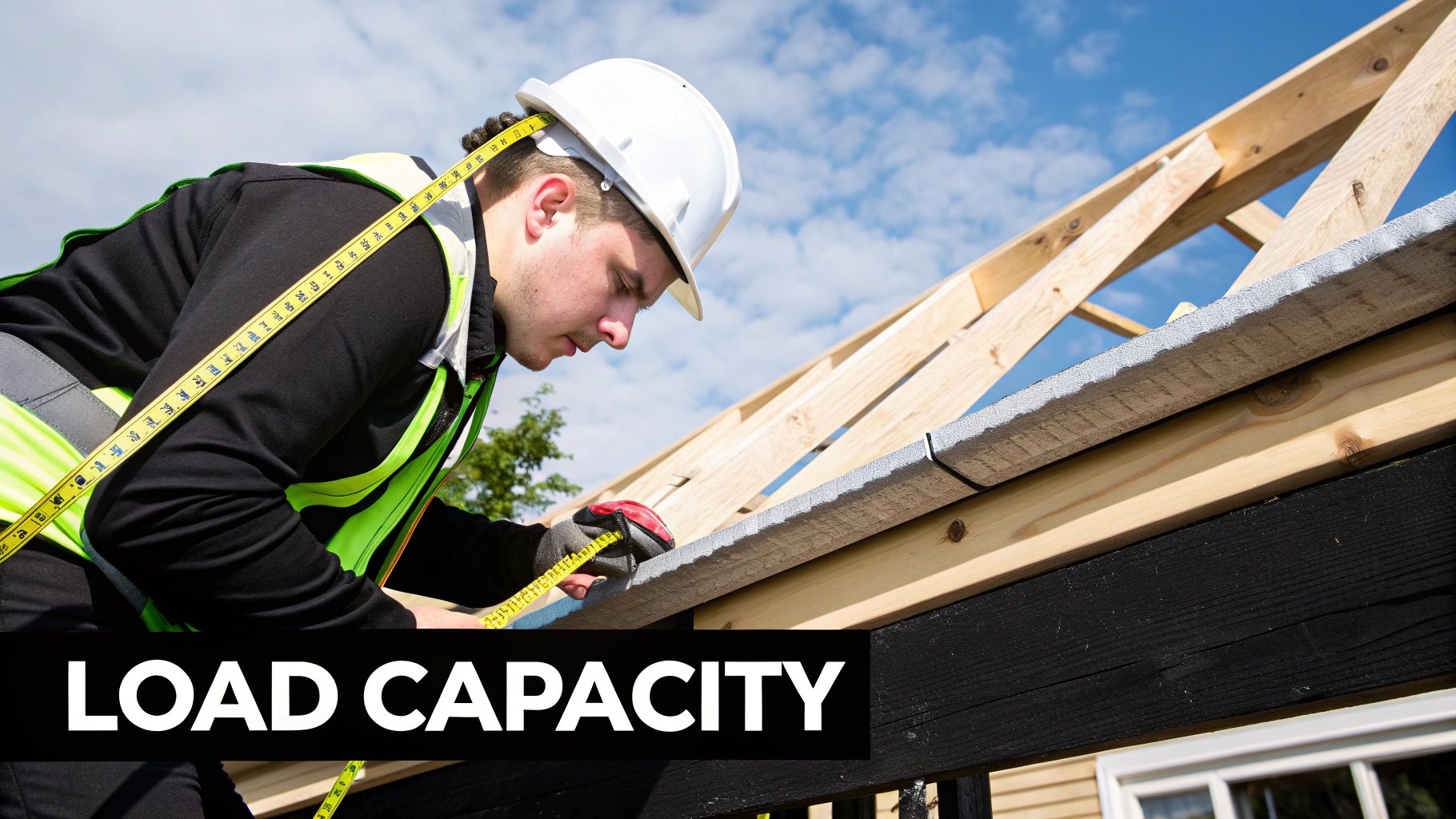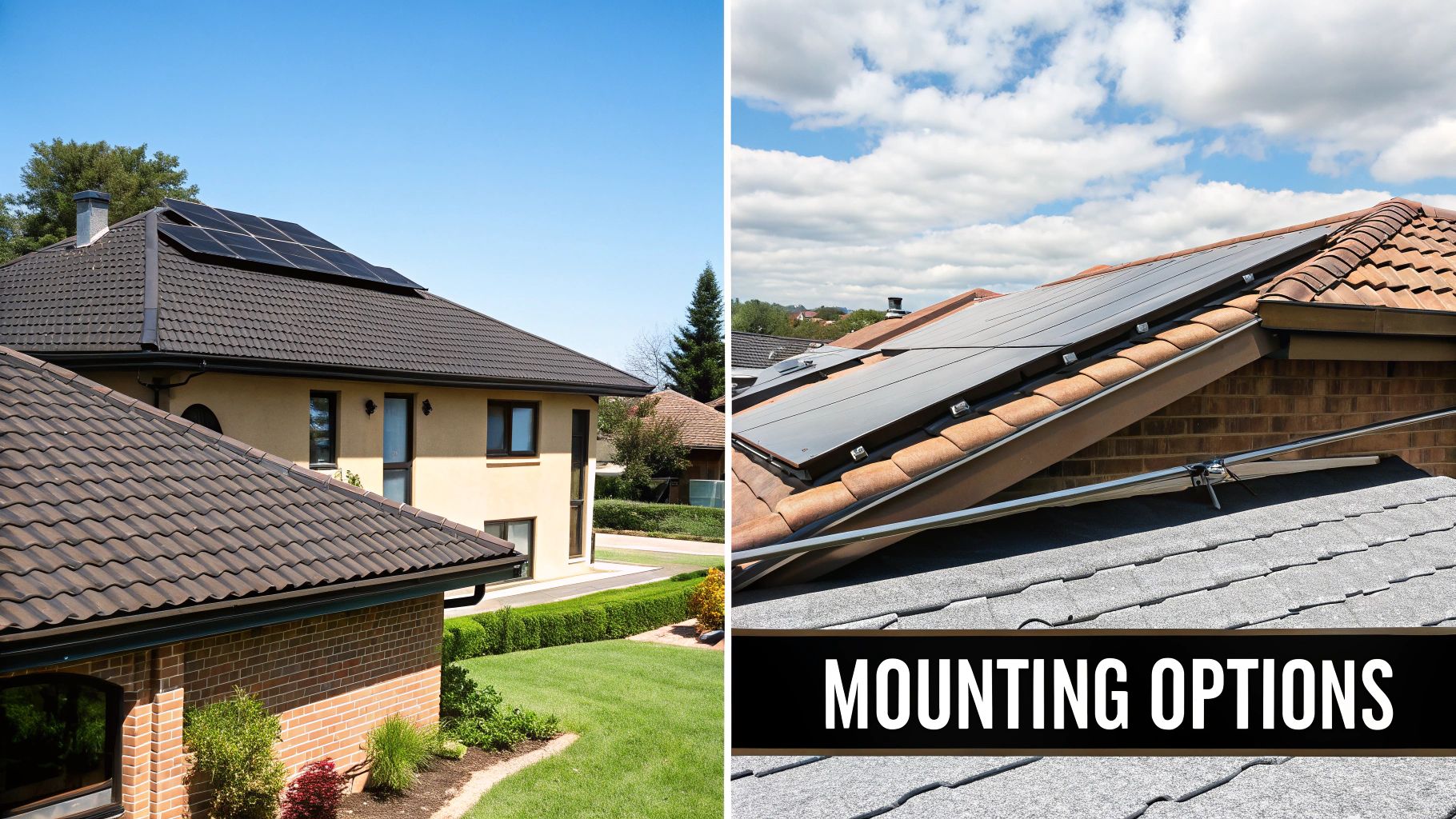
Solar Panel Roof Requirements A Homeowner's Guide
Solar Panel Roof Requirements A Homeowner's Guide
Before you can start harnessing the sun's power, your home first needs to be ready for the job. Getting the most out of a solar panel system starts with your roof—its strength, age, and how it faces the sun are all crucial pieces of the puzzle. Think of it as the foundation for your energy independence. Let our expert solar services guide you through the process, ensuring your home is perfectly prepared.
What Makes a Roof Ready for Solar Panels?
Putting solar panels on your roof is a lot like adding a second story to your house. You wouldn't just start building without first making sure the existing structure could handle the extra weight and stress. The same principle applies here. Your roof is the platform for a powerful energy-generating system, and it needs to be in tip-top shape.
A truly solar-ready roof boils down to four key things: its structural health, its remaining lifespan, how much sun it gets, and how much clear space you have. Get these right, and you’re setting yourself up for a safe, efficient system that will last for decades. While you'll always need a professional to give the final green light, you can easily spot the basics yourself and see if your home is a good starting candidate. To get a definitive answer, contact our solar services for a professional evaluation.
Structural Integrity and Lifespan
First things first: can your roof handle the weight? While a single solar panel is relatively light, a full array of them adds a constant load of about 3 to 5 pounds per square foot. Your roof's underlying structure—the rafters and trusses—must be able to support this extra weight safely for the long haul.
Just as important is the roof's age. Solar panels are built to last 25 years or more. Because of this, installers and local regulations almost always require your roof to have at least 10 to 15 years of life left in it. This simple rule prevents a huge headache down the road: having to pay to remove the entire solar array just a few years later simply to replace old, worn-out shingles.
Sun Exposure and Orientation
How much power your panels generate comes down to one simple factor: sunlight. The more direct sun they soak up, the more electricity you get. This is where your roof’s orientation (the direction it faces) and its tilt (its angle or pitch) become incredibly important.
Here in California, a south-facing roof is the gold standard for all-day sun. But don't worry if your roof doesn't face perfectly south! East and west-facing roofs are also fantastic candidates, often capturing a great deal of morning or afternoon sun, respectively. The main goal is to find a large, open area with minimal shade from trees, vents, chimneys, or that tall two-story house next door. Even a little bit of shade on one panel can affect the performance of the whole system.

As you can see, angling the panels is a science. The right tilt allows them to catch the sun's rays head-on for more hours of the day, which directly translates into more power for your home and bigger savings on your bill.
To help you get a quick overview, here’s a simple checklist of what makes a roof ready for solar.
Quick Checklist for Solar Roof Readiness
This table provides a snapshot of the essential requirements. If your roof checks these boxes, you're likely in a great position to go solar.
Requirement CategoryKey ConsiderationWhy It MattersStructural IntegrityCan support 3-5 lbs/sq ft of added weight.Ensures the safety and stability of your home and the solar array.Roof LifespanAt least 10-15 years of life remaining.Avoids the high cost of removing panels to re-roof your home later.Sun ExposureClear, unobstructed access to sunlight, with minimal shade.Maximizes energy production and your return on investment.Roof OrientationSouth-facing is ideal; East/West are also great options.Determines the time of day your panels will generate the most power.
Making sure your home meets these core solar panel roof requirements is the foundational first step. Once you've confirmed your roof is a solid candidate, you can move forward with confidence. If you're ready to see if your home qualifies, you can get a personalized solar assessment to find out exactly how much you could save. Our solar services include a full evaluation, ensuring your home is perfectly prepared for a high-performance system.
Confirming Your Roof's Structural Strength
Before we even think about placing a solar panel on your roof, we have to tackle the single most important requirement: making sure your roof is up to the job. It's a lot like loading up a bookshelf. You wouldn't stack a heavy set of encyclopedias on a rickety, wobbly shelf, right? The same common sense applies to your home.
Solar panels add what engineers refer to as a continuous load. This isn’t a temporary weight like a pile of snow that will melt away; it’s a permanent addition that will sit on your roof for the next 25 years or more. On average, a complete solar array adds between 3 to 5 pounds per square foot to the roof surface. For a standard home system, that can easily add up to a few thousand pounds of constant pressure.
The entire framework of your roof—the rafters and trusses holding everything up—must be able to handle this extra weight day in and day out without sagging or showing signs of stress. Getting this wrong doesn't just put your solar investment at risk; it could compromise the structural integrity of your entire home.
What a Professional Structural Check Involves
Figuring this out is definitely not a DIY eyeball test. A real structural assessment is a detailed, professional inspection that looks far deeper than just the shingles. A structural engineer or a qualified solar installer will get into the nitty-gritty, examining:
Roof Framing and Supports: They’ll get into your attic to inspect the rafters or trusses, paying close attention to their size, how far apart they are, and their overall condition.
Existing Load Capacity: They do the math to figure out the weight your roof is already carrying and then calculate if it has enough surplus capacity for the new solar system.
Identifying Weak Points: Older homes are especially prone to having outdated construction or unpermitted additions that might create hidden weak spots. A pro knows exactly what to look for.
A proper structural check is non-negotiable. It's the only way to be certain that your home is sound, your family is safe, and your new solar system has a rock-solid foundation for the next quarter-century.
That’s why any reputable solar project always starts here. It’s about building everything on a secure base from the very beginning. We take this so seriously that this meticulous structural check is the first step for every single project we take on.
Ultimately, your peace of mind is what matters most. That’s why our solar services always start with a comprehensive structural evaluation by seasoned professionals. We make absolutely sure your roof is ready for a safe, effective solar installation so you can feel completely confident as you switch to clean energy.
Getting the Most Out of Your Solar Panels

So, your roof is strong enough to hold a solar array. Great. The next big question is, how much good sunlight does it actually get? To figure this out, we need to look at two things: the direction your roof faces (its orientation) and its slope. These are the twin engines that will drive your solar power production.
Think of it this way: your solar panels are like tiny sunbathers. They're happiest—and work best—when they can soak up direct sunlight for as long as possible.
Here in the Northern Hemisphere, south-facing roofs have always been considered the gold standard. They get bathed in sunlight pretty much all day long. But that’s only part of the story. For many California homeowners, an east or west-facing roof can be just as valuable, if not more so.
It’s Not Just About Facing South
While a perfect southern orientation gives you the most total kilowatt-hours over the day, it's not the only way to get fantastic results from your system. What really matters is when you use your electricity.
East-Facing Panels: These are the early birds. They start cranking out power first thing in the morning, which is perfect if your family’s morning routine involves running the dishwasher, coffee maker, and getting ready for the day.
West-Facing Panels: These are the afternoon workhorses. They hit their peak production late in the day, right when people get home, the AC kicks on, and electricity rates are often at their highest.
Lining up your solar production with your own peak energy use is where the real savings happen. This makes your roof's orientation a critical piece of the solar panel roof requirements puzzle.
The Problem of Pesky Shadows
Of course, even the best-placed roof won't do you much good if it’s covered in shade. A beautiful old tree, a chimney, or your neighbor’s new second-story addition can all cast shadows that slash your system's output.
Having enough clear, unshaded space is non-negotiable. In fact, most residential solar projects need at least 300 square feet of usable roof area to make the investment worthwhile. You can learn more about these kinds of installation guidelines in the official documentation from NREL.
You really can't ignore the effect of shade. A small shadow across just one corner of a single panel can hobble the performance of the entire group of panels it's connected to. It’s like stepping on a garden hose—the water pressure drops for the whole length.
The good news is that technology has a smart solution: microinverters. Unlike older systems where panels are linked together, microinverters let each panel operate independently. If one panel gets shaded, the others keep producing at full power, no problem.
Understanding your roof's unique characteristics is the first step toward a successful solar project. Let our experts analyze your roof’s orientation and shading to design a system that works for your home and your lifestyle. Contact our solar services for a detailed, no-cost evaluation.
Choosing the Right Roofing Material and Condition
Once we've figured out your roof’s orientation and structural integrity, we need to look at what it's actually made of. The material on your roof has a surprisingly big impact on how a solar installation is done. Think of it like a foundation—what you build on top of matters. Some materials are a breeze to work with, while others require a more delicate touch.
Luckily, most homes in California have roofing materials that are perfect for solar. The two we see most often are also the most straightforward for our installation teams.
Asphalt Shingles: This is the most common roofing material in the country, and for good reason. It’s also one of the easiest for solar installations. We use a standard, time-tested mounting system with flashing to create a watertight seal that protects your home for decades.
Standing Seam Metal: These roofs are an installer's dream. Instead of drilling into the roof deck, we can use specialized clamps that grip right onto the raised seams. This means no penetrations, which completely preserves the roof’s warranty and integrity.
When you have one of these materials, meeting the solar panel roof requirements is typically simple and keeps your project costs down.
Navigating More Complex Roof Types
What if you don't have asphalt or metal? Don't worry, you can still go solar. It just means the job requires a bit more finesse and specialized hardware, which can add to the overall cost.
Tile roofs, for instance, are very common in California's architectural styles. Whether clay or concrete, these tiles are beautiful but brittle. Our crews have to carefully remove individual tiles to install the mounts directly onto the roof deck underneath. Then, we meticulously cut, flash, and reinstall the tiles to fit perfectly around the hardware, ensuring a seamless and weatherproof finish. Slate and wood shake roofs demand a similar level of expert care to prevent any damage during the process.
The Critical 10-Year Rule
Now, let's talk about the single most important factor: your roof's age and condition. Your solar panel system is built to last, with a lifespan of 25 years or more. Your roof needs to be ready for that same long-term commitment.
This brings us to what we in the solar industry call the 10-year rule. Your roof should have at least a decade of life left in it before we put a single panel on top.
Putting a brand-new solar array on an old, deteriorating roof is a costly mistake we help homeowners avoid every day. If you don't, you'll end up paying twice—once to remove the entire solar system, and again to reinstall it after your roof is replaced. It’s a massive, unnecessary headache. A study even found that 21% of solar installations happen alongside roofing work, which shows how often this needs to be addressed. You can read more about how roof suitability impacts solar adoption on Greenmatch.
This is exactly why a professional roof inspection is one of the very first things we do. It gives you a clear, honest picture of your roof's health and lifespan, so you can make an informed decision. Let our expert team handle this critical evaluation for you. Contact our solar services for a comprehensive roof assessment and a clear path forward.
Getting Through California's Solar Paperwork
Alright, so your roof is in great shape and ready for panels. What’s next? Now we move from the physical work to the paperwork. Handling the structural and material requirements is one part of the puzzle; the other is navigating the world of local permits, electrical codes, and utility agreements.
I know, paperwork can sound intimidating. It often feels like a maze of rules and regulations. But it's all there for a very good reason: safety. These codes and permits are essentially a quality control check, making sure every solar installation is safe for your home, your family, and the first responders who serve your community.
California has always been ahead of the curve with renewable energy. The state even mandated that new homes under three stories built after 2020 must have rooftop solar. This forward-thinking approach is a big reason why California makes up nearly 39% of all solar capacity in the U.S., with over 10 million homes running on solar power as of early 2025. You can dig into more of these impressive solar energy statistics on enkonnsolar.com.
The Main Rules You'll Come Across
Your solar installer will handle the nitty-gritty, but it’s helpful to know what’s going on behind the scenes as your project moves toward approval.
First up is the National Electrical Code (NEC). This is the big one. It sets the gold standard for safe electrical work across the country. The NEC covers everything from how your system is wired and grounded to where the emergency shut-off switches need to go, ensuring the whole setup is free of electrical hazards.
Then, there are local fire safety codes. These rules are all about access. They often require specific "setbacks," which are just clear, empty pathways on your roof.
Think of these setbacks as express lanes for firefighters. They aren't just arbitrary lines on a blueprint; they give first responders a safe, clear path to walk on your roof in an emergency.
Finally, you'll have an interconnection agreement with your local utility company. This is the official contract that gives you permission to connect your solar system to the grid. It lays out the technical rules for a safe connection and explains how you'll get credit for any extra power you send back to the utility.
This is where having an experienced partner really pays off. The permitting and approval process is detailed and can be a headache, but it doesn't have to be your headache. Our team is used to this stuff—we handle all the forms, talk to the local building departments, and make sure every last detail of your system is up to code.
Let us worry about the red tape so you can focus on what matters: the excitement of producing your own clean energy. Contact our solar services today, and we'll manage the entire process for you, from the first sketch to the final inspection.
Take the Next Step with a Professional Roof Assessment

You’ve done your homework—you know the basics about your roof’s structure, material, and sun exposure. That initial self-check is a great first step. But now it’s time to move from learning to action.
To truly confirm that your home meets all the critical solar panel roof requirements, a professional evaluation is non-negotiable. Think of it as the difference between a rough guess and a precise blueprint. An expert assessment ensures your roof can safely handle the load and that your solar investment will actually deliver the energy savings you expect for decades.
A professional roof assessment isn't just a suggestion; it’s the bedrock of a safe, efficient solar energy system and your long-term peace of mind.
This is exactly where we come in. Our team can give you a clear, straightforward evaluation of your home’s solar potential, so you know exactly what’s possible—no guesswork involved.
Don’t leave your home's energy future to chance. When you’re ready for a clear, honest evaluation from a trusted partner, check out our solar services and schedule your free assessment. We’ll deliver a detailed report on your roof's condition and a solid plan for your home's energy independence.
Frequently Asked Questions About Roofs and Solar
Even after getting the basics down on solar panel roof requirements, it's totally normal to have a few lingering questions. Most homeowners we talk to are curious about the real-world, day-to-day side of having a solar array up on their roof. Let's tackle some of the most common concerns we hear.
Will Solar Panels Cause My Roof to Leak?
This is probably the number one worry we hear, and the answer is a firm no—solar panels will not cause roof leaks when they're put in by a certified and experienced pro.
Reputable installers use specialized mounting and flashing systems that are designed for one purpose: to create a completely watertight seal around every single spot where the system attaches to your roof. Think of it like a perfectly fitted gasket. These systems are engineered to work with your specific roofing material, channeling water away from the connection points, not into them. The whole secret to a leak-free system is simply choosing a qualified team that uses top-tier materials and sticks to proven installation methods.
Peace of mind is everything. A professional installation always includes heavy-duty weatherproofing, and it's usually backed by warranties on both the equipment and the installation itself. Your roof's integrity is protected.
Can I Install Solar Panels on a Flat Roof?
You absolutely can. In fact, flat roofs can be fantastic for solar. Instead of putting the panels flush against the roof surface, installers use a special racking system that tilts them up to the perfect angle to catch the most sun.
There are generally two ways to do this:
Ballasted Systems: These setups use heavy blocks to weigh the system down, holding everything securely in place without drilling any holes.
Mechanically Attached Systems: This more traditional method involves anchoring the racking directly to the roof's structure, using robust waterproofing seals at every attachment point for maximum security.
Before anything happens, a structural engineer will confirm that your roof can easily support the weight of the panels and the racking. But most of the time, flat roofs provide a really flexible and efficient foundation for a solar array.
What if My Roof Does Not Face Directly South?
A south-facing roof is the classic "ideal" here in California, but it's far from a deal-breaker. Roofs that face east or west can be just as effective and sometimes even offer some unique benefits.
An east-facing array gets a head start, producing lots of power in the morning. A west-facing system hits its stride in the afternoon, which is perfect for matching your home's peak energy use when you get home from work. It's all about aligning production with your lifestyle.
In places with tons of solar like California and Germany, strict building and electrical codes dictate every part of the installation, from the wiring to the roof attachments, ensuring safety and longevity no matter which way your roof faces. You can find more details about these global solar standards and practices on nrel.gov. Our design team will look at your specific roof and energy habits to build a system that gives you the best possible financial return.
Still have questions about your own roof? We're here to give you clear, straightforward answers. You can get in touch with our solar experts for a no-pressure chat about your home.
Ready to turn these answers into action? The team at Rate Reduction California is here to guide you through every step. Let our solar services experts provide a professional evaluation and design the perfect system for your home's unique needs.